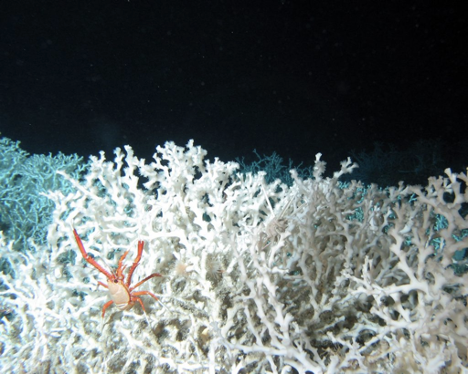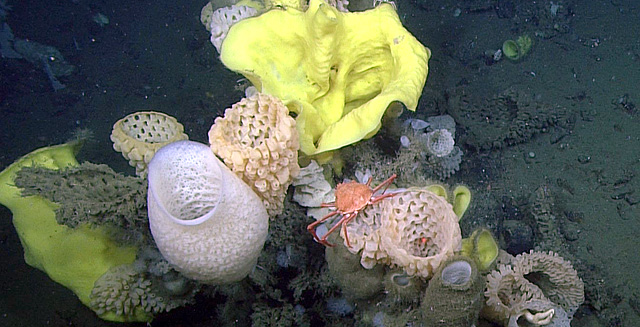Written By Laura Anthony

For many, the word reef conjures up images of snorkeling in bath-temperature water above vibrant corals and fishes next to a sunny beach. Yet there are more species of corals that illuminate the wintery waters of the deep sea, forming habitats that rival the colors and biodiversity of shallow-water reefs. Cold-water coral and sponge reefs are found around the globe at all latitudes and depths. Anything below 200 meters is deemed “deep-sea,” out of the reach of light. Unlike their shallow-water cousins, cold-water corals don’t have symbiotic algae that provides food via photosynthesis, so they rely on food falling from the sea surface.
Reefs in the deep
Originating from the Norwegian term “rif,” a reef historically referred to corals presenting a danger to ships. However, deep-sea corals can form massive three-dimensional structures thousands of meters underwater, far out of the reach of ships. Thus, deep-sea scientists debate still today about when and if they should use the term to describe most cold-water coral and sponge ecosystems. Cold-water stony corals can settle on the dead skeletons of previous corals, forming large structures typically called reefs, mounds, and hills. The best studied deep-sea coral is Desmophylum pertusum, previously named Lophelia pertusa, because it forms large reef-structures in the northern hemisphere, while Solenosmilia variabilis forms bright orange reefs in the southern hemisphere. In addition to reefs formed by hard corals, octocorals and black corals form deep-sea coral gardens and beds. Even sponges can form large reef structures in the deep!

Deep-sea sponge community on Sur Ridge
Species associations
Though not as familiar as the bond between clownfish and anemone, the symbiotic relationship between the coral Desmophylum pertusum and the worm Eunice norvegica is equally fascinating. The worm steals food from the coral polyps, but repays the debt by moving coral fragments together to strengthen the reef framework. In addition, commercial fishes use deep-sea coral and sponge habitats as nursery and feeding grounds, and many other suspension-feeding invertebrates settle at the tops of reefs to feed above the slow moving water nearest the seafloor.

Threats to deep-sea reefs
Although the deep sea seems far out of the reach of humans, our actions still impact deep-sea corals and sponges. Climate change is warming the deep waters, depleting the oxygen necessary to life. Ocean acidification is dissolving coral skeletons in the deep sea more rapidly than seen in shallow-water corals. As cold-water coral and sponge ecosystems harbor commercial species, fishing activity can destroy the structure-forming species. Even trash from land can reach the deep sea and become entangled in corals and sponges. Fortunately, as the technology for ocean exploration advances, increased understanding of deep-sea coral and sponge ecosystems allows us to make educated management decisions.
References
Miller, Karen J., & Rasanthi M. Gunasekera. 2017. A comparison of genetic connectivity in two deep sea corals to examine whether seamounts are isolated islands or stepping stones for dispersal. Scientific Reports 7: 1–14.
Oppelt, Alexandra, Matthias López, Carlos Rocha. 2017. Biogeochemical analysis of the calcification patterns of cold-water corals Madrepora oculata and Lophelia pertusa along contact surfaces with calcified tubes of the symbiotic polychaete Eunice norvegica: Evaluation of a ‘mucus’ calcification hypothesis. Deep-Sea Research Part I: Oceanographic Research Papers 127: 90–104.
Roberts, J. Murray, Andrew Wheeler, Andre Friewald, Stephen Cairns. 2009. Cold-Water Corals: The Biology and Geology of Deep-Sea Habitats. Cambridge University Press, New York, United States.
Rogers, Alex D., Andrew S. Brierley, Peter L. Croot. 2015. Delving Deeper: Critical challenges for 21st century deep-sea research. European Marine Board: Technical Report
“Seafloor Ecology Spring Expedition.” n.d. Monterey Bay Aquarium Research Institute

Fascinating to learn about the deep sea corals around temperate shores. They may not have ‘in-house’ symbiotes in the same way as the GBR and its kin but the manner in which they gain their nutrition sounds every bit as intriguing.
I came by your site via my very long-term interest in the course ‘Exploring Our Ocean(s)’ on the FutureLearn education platform and it sparked something which will stay with me for the rest of my life. As a newbie OAP now and having been ‘befriended’ by MS for two-thirds of that time with pretty much all its progressive consequences, it’s great to acquire a new stem to that interest, even at this late stage.
LikeLike
Lee Scott, we are glad you found our blog and we are grateful for your support and kind words!
LikeLike